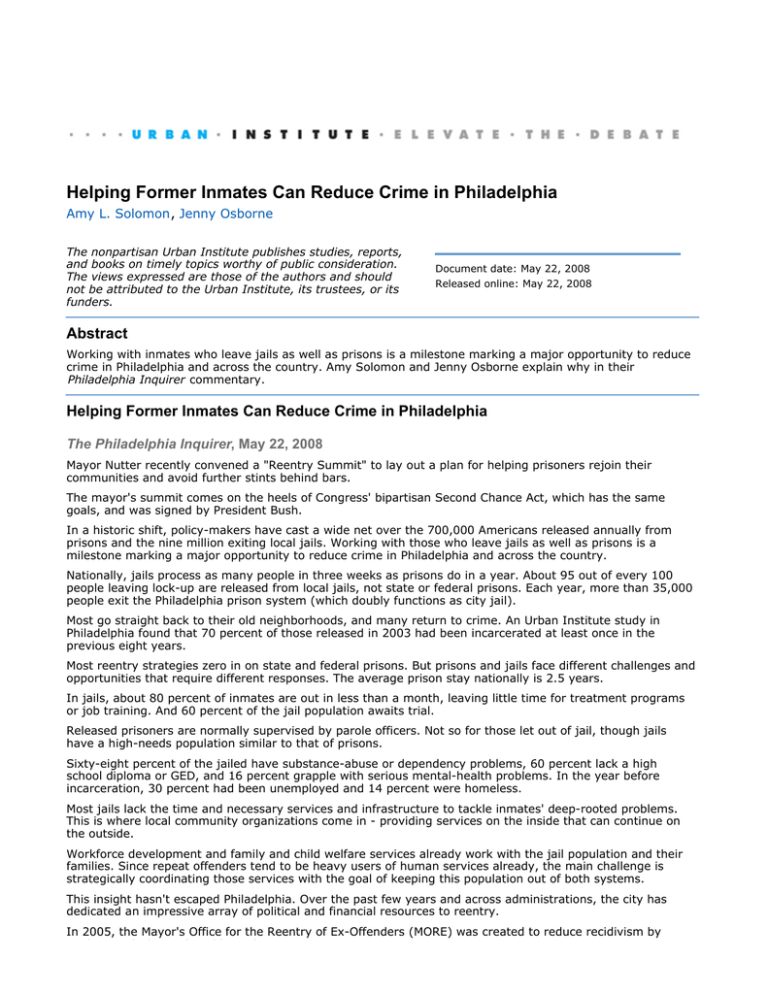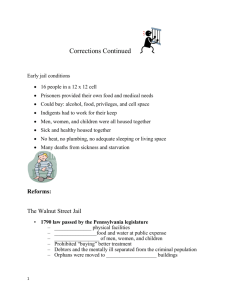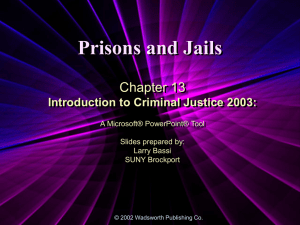Helping Former Inmates Can Reduce Crime in Philadelphia Amy L. Solomon ,
advertisement

Helping Former Inmates Can Reduce Crime in Philadelphia Amy L. Solomon, Jenny Osborne The nonpartisan Urban Institute publishes studies, reports, and books on timely topics worthy of public consideration. The views expressed are those of the authors and should not be attributed to the Urban Institute, its trustees, or its funders. Document date: May 22, 2008 Released online: May 22, 2008 Abstract Working with inmates who leave jails as well as prisons is a milestone marking a major opportunity to reduce crime in Philadelphia and across the country. Amy Solomon and Jenny Osborne explain why in their Philadelphia Inquirer commentary. Helping Former Inmates Can Reduce Crime in Philadelphia The Philadelphia Inquirer, May 22, 2008 Mayor Nutter recently convened a "Reentry Summit" to lay out a plan for helping prisoners rejoin their communities and avoid further stints behind bars. The mayor's summit comes on the heels of Congress' bipartisan Second Chance Act, which has the same goals, and was signed by President Bush. In a historic shift, policy-makers have cast a wide net over the 700,000 Americans released annually from prisons and the nine million exiting local jails. Working with those who leave jails as well as prisons is a milestone marking a major opportunity to reduce crime in Philadelphia and across the country. Nationally, jails process as many people in three weeks as prisons do in a year. About 95 out of every 100 people leaving lock-up are released from local jails, not state or federal prisons. Each year, more than 35,000 people exit the Philadelphia prison system (which doubly functions as city jail). Most go straight back to their old neighborhoods, and many return to crime. An Urban Institute study in Philadelphia found that 70 percent of those released in 2003 had been incarcerated at least once in the previous eight years. Most reentry strategies zero in on state and federal prisons. But prisons and jails face different challenges and opportunities that require different responses. The average prison stay nationally is 2.5 years. In jails, about 80 percent of inmates are out in less than a month, leaving little time for treatment programs or job training. And 60 percent of the jail population awaits trial. Released prisoners are normally supervised by parole officers. Not so for those let out of jail, though jails have a high-needs population similar to that of prisons. Sixty-eight percent of the jailed have substance-abuse or dependency problems, 60 percent lack a high school diploma or GED, and 16 percent grapple with serious mental-health problems. In the year before incarceration, 30 percent had been unemployed and 14 percent were homeless. Most jails lack the time and necessary services and infrastructure to tackle inmates' deep-rooted problems. This is where local community organizations come in - providing services on the inside that can continue on the outside. Workforce development and family and child welfare services already work with the jail population and their families. Since repeat offenders tend to be heavy users of human services already, the main challenge is strategically coordinating those services with the goal of keeping this population out of both systems. This insight hasn't escaped Philadelphia. Over the past few years and across administrations, the city has dedicated an impressive array of political and financial resources to reentry. In 2005, the Mayor's Office for the Reentry of Ex-Offenders (MORE) was created to reduce recidivism by working with the city's public and private organizations on prisoner reintegration. working with the city's public and private organizations on prisoner reintegration. In 2007, the city opened two one-stop centers for former inmates seeking help from justice-system agencies, behavioral health providers, housing agencies, and faith-based organizations. The mayor is banking on collaborative reentry strategies to increase public safety and reduce public spending. The Philadelphia model awaits evaluation, but early results in other jurisdictions are promising. For example, a University of Pittsburgh evaluation of the Allegheny County Jail Collaborative found a 50 percent drop in recidivism rates for the 300 participants studied, amounting to annual savings of more than $5.3 million. These benefits could expand exponentially if the approach were used across Pennsylvania and the country. Multiplying such gains will require changing the way local governments, community organizations, and jails prepare inmates for their transition home. This is no easy feat since there are 3,365 independently operated U.S. jails. If Congress funds the authorized $320 million for the Second Chance Act, it could speed adoption of local reentry collaboratives. But even small, low-cost changes such as giving inmates information about local service providers and making sure released prisoners leave with valid IDs can make a difference. Stints in jail can be much more than temporary time-outs. They represent opportunities to intervene in nine million lives, to start dealing with pressing risks and needs, and to reduce repeat offending - creating safer, healthier communities for all. Other Publications by the Authors Amy L. Solomon Jenny Osborne Usage and reprints: Most publications may be downloaded free of charge from the web site and may be used and copies made for research, academic, policy or other non-commercial purposes. Proper attribution is required. Posting UI research papers on other websites is permitted subject to prior approval from the Urban Institute—contact publicaffairs@urban.org. If you are unable to access or print the PDF document please contact us or call the Publications Office at (202) 261-5687. Disclaimer: The nonpartisan Urban Institute publishes studies, reports, and books on timely topics worthy of public consideration. The views expressed are those of the authors and should not be attributed to the Urban Institute, its trustees, or its funders. Copyright of the written materials contained within the Urban Institute website is owned or controlled by the Urban Institute. Source: The Urban Institute, © 2012 | http://www.urban.org


